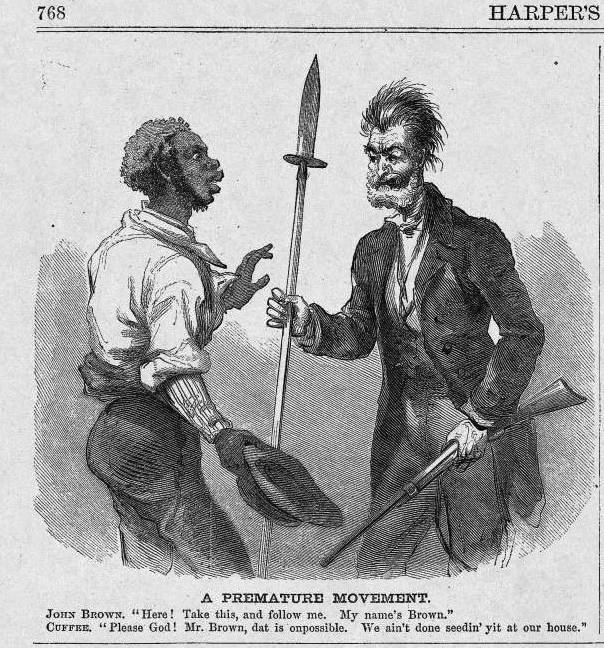"A Premature Movement"
Harpers Weekly was a Republican periodical. Its cartoons, illustrated by the famous Thomas Nast, traditionally favored the North in their expression. They did not even keep letters from their southern readers.[1] The political leanings of Nast are evident throughout his illustrations, as his “passionate devotion to the Union, his opposition to slavery…are all present, almost from the beginning of his war work.”[2]
In the cartoon titled “A Premature Movement,” a white man, John Brown, is seen trying to recruit a black man, Cuffee, to come with him. Brown says, “Here! Take this, and follow me. My name’s Brown.” Cuffee replies, “Please God! Mr. Brown, dat is onpossible. We ain’t done seedin’ yit at our house.”[3] From the get-go, the cartoon plays to the physical stereotypes of black men. Cuffee the slave is depicted with large lips and round buttocks compared to John Brown. Brown is depicted as rough-looking, with a pinched face and unkempt hair, and potentially hostile as he is holding a rifle.
This cartoon is satirizing John Brown’s raid on Harpers Ferry. The raid was a major event in the prewar period. The plot began with a group called the “Secret Six,” an assembly of men who gathered together under the guidance of John Brown to plan the raid and raise funds for the cause. Brown strongly believed that slaves should participate in the fight against the institution that bound them.[4] In summer of 1859, Brown and his followers traveled to Harpers Ferry and rented Kennedy Farm, located just outside of Harpers Ferry.[5] The raid on Harpers Ferry occurred the night of October 16th, 1859, when Brown and his men “capture[d] its federal arsenal.”[6] The military quickly shut down Brown’s raid, as not as many slaves joined in as he expected, and they were forced to retreat.[7] Resulting in seventeen deaths, the raid lasted a total of two days, ending with Brown’s capture on October 18th.[8] Brown was “convicted of murder, treason, and inciting a slave insurrection,” and executed a month later.[9]
The cartoon satirizes this event by focusing on the fact that few slaves came to join Brown’s raid at Harpers Ferry. Brown’s plan counted on the local slaves to come join his forces when they heard of the uprising. This was largely due to the importance Brown placed on slaves fighting for their own freedom. So when hardly any slaves showed up, the raid failed quickly. The cartoon shows Brown handing a black man (presumably a slave) a weapon and asking him to join him. Readers, well aware of John Brown by this time, would have recognized that this was depicting Brown’s attempts to recruit slaves to participate in his rebellion.
Cuffee, the black male slave in this cartoon, tells Brown that he cannot join him, for he has more work to finish at the house (presumably of his master). This dialogue amuses the reader with the idea that the raid at Harpers Ferry was the irrational plan of John Brown, and no slaves would join him in the execution of his plan because of their obedience and devotion to their work.
The title, “A Premature Movement,” aids in this interpretation. The idea of the movement being “premature” relates to Brown’s lack of preparation or communication in organizing a sufficient number of slaves to join in the uprising. Another interpretation of “premature” could be that Brown’s assumption that the local slaves would jump at the chance to participate in an uprising was foolish and unrealistic. Therefore the movement was premature either due to lack of preparation of support from the slave community.
Overall the cartoon effectively satirizes John Brown’s failure to create a successful slave rebellion at Harpers Ferry. Through the dialogue and illustration, the slave is depicted as obedient to his work or unreceptive to the idea of revolt, and Brown as hostile and rebellious in attempting to arm slaves.
Endnotes:
[1] Hall, Thomas Nast, 66
[2] Hall, Thomas Nast, 68
[3] Harpers Weekly, 768
[4] Kylte, A Transcendentalist Above All
[5] Kylte, A Transcendentalist Above All, Finkelman, Terrible Swift Sword, xxx
[6] Kylte, A Transcendentalist Above All
[7] Kylte, A Transcendentalist Above All
[8] Kylte, A Transcendentalist Above All; Finkelman, Terrible Swift Sword, xxx
[9] Finkelman, Terrible Swift Sword, xxx
Bibliography:
Finkelman, Paul and Russo, Peggy A. Terrible Swift Sword: The Legacy of John Brown. Athens: Ohio University Press: 2005.
Halloran, Fiona Deans. Thomas Nast: The Father of Modern Political Cartoons. Chapel Hill: The University of North Carolina Press, 2012.
Kytle, J. Ethan. “A Transcendentalist Above All: Thomas Wentworth Higginson, John Brown, and the Raid at Harpers Ferry,” Journal of the Historical Society 12, no. 3 (September 2012): 283-308.
Harper’s Weekly 3, no. 152 (November 1859): 768. accessed 2 February 2015: http://app.harpweek.com.prox.lib.ncsu.edu/viewarticletext.asp?webhitsfile=hw18591126000011%2Ehtm&xpath=%2FTEI%2E2%5B1%5D%2Ftext%5B1%5D%2Fback%5B1%5D%2Fdiv1%5B42%5D%2Fp%5B9%5D%2Ffigure%5B1%5D&xml=HW%5C1859%5C18591126%2Exml&titleid=HW&volumeid=1859&issueid=1126&pagerange=0768ab%2D0768ab&restriction=brown+&pageIds=%7CHW%2D1859%2D11%2D26%2D0768%7C
